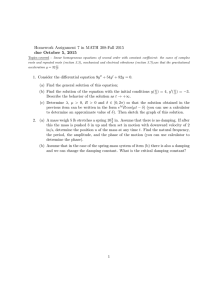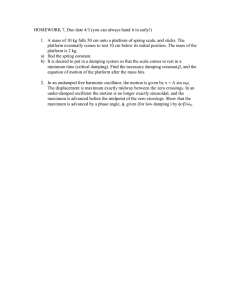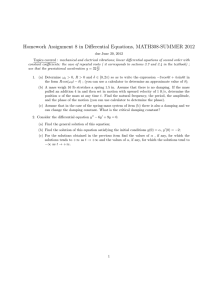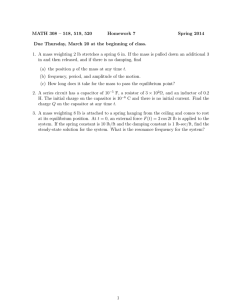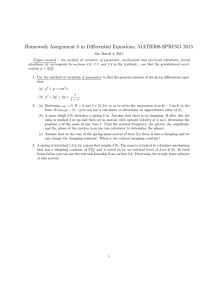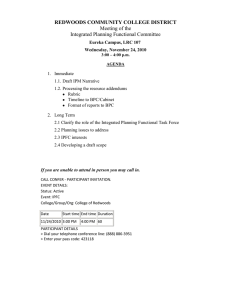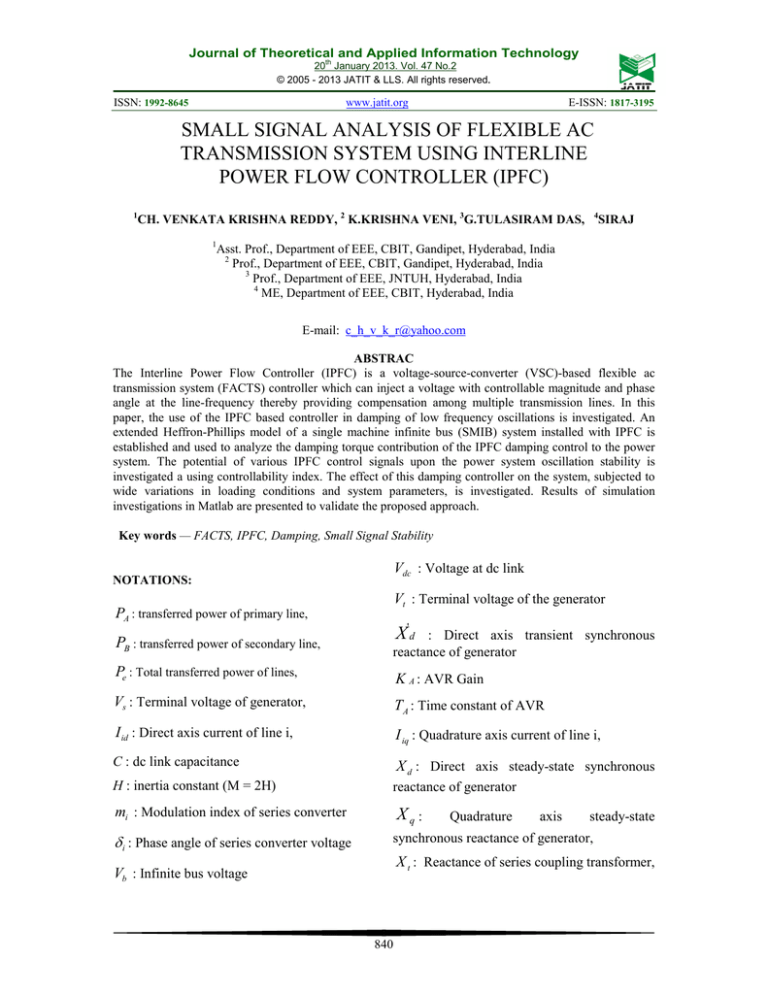
Journal of Theoretical and Applied Information Technology
20th January 2013. Vol. 47 No.2
© 2005 - 2013 JATIT & LLS. All rights reserved.
ISSN: 1992-8645
www.jatit.org
E-ISSN: 1817-3195
SMALL SIGNAL ANALYSIS OF FLEXIBLE AC
TRANSMISSION SYSTEM USING INTERLINE
POWER FLOW CONTROLLER (IPFC)
1
CH. VENKATA KRISHNA REDDY, 2 K.KRISHNA VENI, 3G.TULASIRAM DAS,
1
4
SIRAJ
Asst. Prof., Department of EEE, CBIT, Gandipet, Hyderabad, India
2
Prof., Department of EEE, CBIT, Gandipet, Hyderabad, India
3
Prof., Department of EEE, JNTUH, Hyderabad, India
4
ME, Department of EEE, CBIT, Hyderabad, India
E-mail: c_h_v_k_r@yahoo.com
ABSTRAC
The Interline Power Flow Controller (IPFC) is a voltage-source-converter (VSC)-based flexible ac
transmission system (FACTS) controller which can inject a voltage with controllable magnitude and phase
angle at the line-frequency thereby providing compensation among multiple transmission lines. In this
paper, the use of the IPFC based controller in damping of low frequency oscillations is investigated. An
extended Heffron-Phillips model of a single machine infinite bus (SMIB) system installed with IPFC is
established and used to analyze the damping torque contribution of the IPFC damping control to the power
system. The potential of various IPFC control signals upon the power system oscillation stability is
investigated a using controllability index. The effect of this damping controller on the system, subjected to
wide variations in loading conditions and system parameters, is investigated. Results of simulation
investigations in Matlab are presented to validate the proposed approach.
Key words — FACTS, IPFC, Damping, Small Signal Stability
Vdc : Voltage at dc link
NOTATIONS:
Vt : Terminal voltage of the generator
PA : transferred power of primary line,
X'd
PB : transferred power of secondary line,
: Direct axis transient synchronous
reactance of generator
Pe : Total transferred power of lines,
K A : AVR Gain
Vs : Terminal voltage of generator,
TA : Time constant of AVR
I id : Direct axis current of line i,
I iq : Quadrature axis current of line i,
C : dc link capacitance
X d : Direct axis steady-state synchronous
H : inertia constant (M = 2H)
reactance of generator
mi : Modulation index of series converter
Xq :
δ i : Phase angle of series converter voltage
synchronous reactance of generator,
Quadrature
axis
steady-state
X t : Reactance of series coupling transformer,
Vb : Infinite bus voltage
840
Journal of Theoretical and Applied Information Technology
20th January 2013. Vol. 47 No.2
© 2005 - 2013 JATIT & LLS. All rights reserved.
ISSN: 1992-8645
www.jatit.org
1. INTRODUCTION
Low frequency oscillations with frequency in the
range of 0.2 to 2.0 Hz are one of the results of the
interconnection of large power systems. Modem
power systems are stable if electromechanical
oscillations occurring in each area can be damped
as soon as possible. To increase power system
oscillations stability, Power System Stabilizer (PSS)
is a simple, effective, and economical method [1].
"Flexible AC Transmission Systems (FACTS)"
technology has been proposed during the last three
decades and provides better utilization of existing
systems. Interesting FACTS capabilities such as
power flow control, damping of power system
oscillations, voltage regulation, and reactive power
compensation make them a good option for
effective utilization of power systems. In this paper
one of the FACTS capabilities is damping inter-area
oscillations that will be accurately investigated for
IPFC.
Interline Power Flow Controller, which is
proposed by Guygyi and etal [2] in l998, is a
FACTS controller for series compensation with
unique capability of power flow management
between multi-lines of a substation. In the IPFC
structure a number of inverters are linked together
at their dc terminals. Each inverter can provide
series reactive compensation, as an SSSC, for its
own line. However, the inverters can transfer real
power between them via their common dc terminal.
This capability allows the IPFC to provide both
reactive and real compensation for some of the lines
and thereby optimize the utilization of the overall
transmission system.
Like other FACTS elements, IPFC can be used
for increasing power system stability against large
and small disturbances.
In this paper the voltage of coupling capacitance
between two VSC-based converters is used as a
state variable. Output power of the generator is used
as an input of PI controller, which creates proper
amplitude modulation ratio for the secondary
converter.
E-ISSN: 1817-3195
transmission lines, connects the generator G to an
infinite bus, is illustrated in figure 1.
Figure 1 Single Machine Infinite Bus System With IPFC
PSS is not taking into account in the power
system. Operating conditions and parameters are
represented in the appendix.
Phillips-Heffron linear model of a single-machine
infinite bus system with IPFC is derived from the
nonlinear differential equations. Neglecting the
resistances of all the components of the system like
generators, transformers, transmission lines, and
series converter transformers, a nonlinear dynamic
model of the system is derived as follows:
•
δ = ω o (ω − 1 )
•
ω=
•
-------- (1)
[Pm − Pe − D(ω − 1)]
--------- (2)
M
(
= [− E
)
+ K (V
E ' q = − Eq + E .fd / Tdo'
•
E fd
fd
A
ref
--------- (3)
]
− Vs ) / TA --------- (4)
Where,
Pe = P1 + P2
-------- (5)
Pe = Vsd ( I1d + Vsq I 2d ) + ( I 1q + I 2 q ) --------- (6)
2. DYNAMIC MODEL OF THE SYSTEM
WITH IPFC
E q = E ' q +( X d - X 'd )( I1d + I 2d )
------- (7)
A single-machine infinite-bus (SMIB) system
with IPFC, installed on two lines is considered. This
configuration which consists of two parallel
Vs = Vsd + j Vsq
--------- (8)
841
'
'
= X q I1q +j[ E q - X d ( I1d + I 2 d )]
Journal of Theoretical and Applied Information Technology
20th January 2013. Vol. 47 No.2
© 2005 - 2013 JATIT & LLS. All rights reserved.
ISSN: 1992-8645
www.jatit.org
E-ISSN: 1817-3195
If the general Pulse Width Modulation (PWM) is
used for VSCs, the voltage equations of the IPFC
converters in dq coordinates will be [1]:
− X t I 1d Vdc m1 cos δ 1
+
0 I 1q 2 m 2 cos δ 2
V p1 0
V =
q1 X t
-------- (9)
− X t I 2 d Vdc
+
0 I 2 q 2
V p 2 0
V =
q2 X t
m1 sin δ1
m sin δ
2
2
-------- (10)
Figure 2.Phasor diagram of investigated system
where,
V pqK = V pK + j VqK = V pqK
e jδ k
---------- (11)
[
dVdc 3m1
I1d cos δ1 + I1q sin δ1
=
dt
4C
3m
+ 2 I 2 d cos δ 2 + I 2 q sin δ 2
4C
[
]
' Vdc
X d ∑ I1d Eq − 2 m2 sin δ 2 − Vb cos δ
=
− X TL I 2 d Vdc (m sin δ − m sin δ )
2
2
1
1
2
X ds
X
TL
]
---------- (12)
From figure 1, we have:
Vs = j X s I s + V pq 2 + j X L I 2
From (6) to (12), it can be obtained:
----- (17)
X qs
− X
TL
--------- (13)
Vdc
X q ∑ I1q 2 m2 cos δ 2 + Vb sin δ
=
X TL I 2 q Vdc (m cos δ − m cos δ )
2
2
1
1
2
----- (18)
This equation in d-q coordinates is as follows:
where,
X qs = X q + X s
Vsd + j Vsq = j X s [( I1d + I 2d )+j( I1q + I 2 q )]+
+j X L ( I 2 d +j I 2 q )+ V p 2 + Vb sin δ
+ jVb cos δ
------------ (14)
In the other hand, according to figure 2, we have:
Vsd = X q ( I1q + I 2 q )
'
'
---------- (15)
Vsq = E q -( X d - X d )( I1d + I 2d ) --------- (16)
and
-------- (19)
X TL = X t + X L
-------- (20)
X dΚ = X ds - X TL
-------- (21)
X qΚ = X qs + X TL
-------- (22)
X ds = X ' d + X s
-------- (23)
X L is the series reactance of each transmission
line.
3. LINEAR DYNAMIC MODEL
Power system oscillation stability and control can
be studied using a linearized model of the power
systems.
A linear dynamic model of the system illustrated
in figurel, is obtained by linearising the nonlinear
model of the system presented in above section,
842
Journal of Theoretical and Applied Information Technology
20th January 2013. Vol. 47 No.2
© 2005 - 2013 JATIT & LLS. All rights reserved.
ISSN: 1992-8645
www.jatit.org
around an operating condition. The linearized
model is as follows:
ωo
0
• −K
1
∆ δ•
∆ω M
•1 − K 4
∆ Eq = T '
do
•
∆ E fd − K A K 5
• TA
∆ V dc
K7
0
K pm1
− M
−K
qm1
+
Td' o
K K
− A vm1
TA
K cm1
0
− K2
M
− K3
Td' o
K K
− A 6
TA
K8
−D
M
0
0
0
−
0
K pδ 1
−
M
− K qδ 1
0
0
1
Td' o
1
TA
0
0
K pm 2
M
− K qm 2
Td' o
K K
− A vδ 1
TA
K cδ 1
Td' o
K K
− A vm 2
TA
K cm 2
Phillips-Heffron model or linear model of the SMIB
system can be obtained including IPFC [3].
0
K pv ∆ δ
M ∆ω
− K qv
∆ E q1 +
Td' o
K K
− A vv ∆ E fd
TA ∆ V
dc
− K9
−
Where
U = ∆m1
K p = K pm1
0
K pδ 2 ∆m
1
−
M ∆δ
− K qδ 2 1
∆m 2
Td' o
K K
∆δ 2
− A vδ 2
TA
K cδ 2
-------- (24)
In the state-space representation, the power system
can be modeled as
•
X = AX + BU
∆ω
∆E q'
∆Vdc
∆E fd
∆δ 1
∆m 2
K pδ 1
K q = K qm1
K qδ 1
K qm 2
K v = K vm1
K vδ 1
K vm 2
T
K pδ 2
K pm 2
K qδ 2
T
K vδ 2
Pe = 0.900,
Q = 0.1958
T
Vs = 1.02
Vb = 1
V pq1 = 0.3795 Vdo = 0.4311
Vqo = 0.9244 I do = 0.5469
T
δ o = 7.6056
T
U = ∆m1 ∆δ 1 ∆m 2 ∆δ 2
∆m1 is the deviation in pulse width modulation
index m1 of voltage series converter-1 in line-1. By
controlling m1 , the magnitude of series injected
∆δ 2
This model has 28 constants, presented below
and, are functions of the system parameters and
initial operating condition stated below.The system
is incorporated with IPFC. Load flow analysis is
performed to obtain the operating point which is
given as follows:
Where the state vector and control vector are as
follows:
X = ∆δ
E-ISSN: 1817-3195
o
I qo = 0.7185
δ 1o = 71.5651 δ 2o = 7.725o
o
The system is linearized about this operating
point. The K-constants for the system installed with
IPFC, are computed as follows:
voltage in line-1 can be controlled.
∆m2 is the deviation in pulse width modulation
index m2 of voltage series converter-2 in line-2.By
controlling m2 , the magnitude of series injected
voltage in line-2 can be controlled.
∆δ 1 is the deviation in phase angle of the injected
voltage V pq1 .
∆δ 2 is the deviation in phase angle of the injected
voltage V pq 2 .
∆Vdc is the deviation of coupling capacitance
voltage between converters,
Using the mathematical model of the SMIB with
IPFC as state space representation in (24), the
843
K 1 = 2.0552
K 3 = 0.7333
K 2 = 0.0413
K 4 = 0.000001
K 5 = 0.0185
K 6 = 0.6001
K 7 = −0.0885
K 9 = 7.6663 × 10 −4
K 8 = −0.1088
K pv = 0.0672
K qv = −0.0087
K vv = −0.0116
K pm1 = 0.0552
K pm 2 = 0.2530
K pδ 1 = 0.0376
K pδ 2 = −0.0045
K qm1 = −0.0326
K qδ 1 = 0.0010
K qm 2 = 0.0056
K qδ 2 = 0.0033
K vm1 = −0.0360
K vδ 1 = −0.0029
K vm 2 = −0.0038
K vδ 2 = −0.0021
T
Journal of Theoretical and Applied Information Technology
20th January 2013. Vol. 47 No.2
© 2005 - 2013 JATIT & LLS. All rights reserved.
ISSN: 1992-8645
www.jatit.org
∆Pe
,(phase lag of between ∆u and ∆Pe
∆u
, where ∆u = ∆m1 , ∆δ 1 , ∆m2 and ∆δ 2 as
K cm1 = 7.6663 × 10 −4 K cδ 1 = 0.0672
K cm 2 = −0.0087
G s (s ) =
K cδ 2 = −0.0116
4. DESIGN OF IPFC DAMPING
CONTROLLERS
deviation ∆ω is considered as the input to the
damping controllers which reflects the swings on
the machines and lines of interest. As such, the
output of the controller is in phase with the speed
deviation.
Fig. 3 Structure of IPFC based damping controller
The structure of IPFC based damping controller
is shown in Fig.3. It consists of gain, signal washout
and phase compensation blocks. The optimum
parameters of the damping controller are obtained
using the phase compensation technique [4]. The
design is presented as below. The time constants of
the phase compensator are chosen such that the
phase angle of the system is fully compensated. For
the nominal operating condition, the magnitude and
phase angle of transfer function, ∆ Pe /∆U, will be
s = jω n . The gain setting of the
damping controller is chosen to achieve the
required damping ratio of 0.1. As observed from
(24) there are four choices of input signals
( m1 , δ 1 , m2 and δ 2 ) of the IPFC to modulate. The
signal which can achieve effective damping control
at minimum control cost will be the most efficient.
This selection is made at open loop condition
before installation of damping controller. The
concept of controllability index is used to select the
most suitable IPFC control parameter from the
damping controller for modulation [5].
(1). Compute the natural frequency of oscillation
ωn from the mechanical loop as
(2). Let γ be the angle of the transfer function
]
s = jω n .
(3). The controller designed is made up of washout
filter and lead-lag block, with the following transfer
function:
G s (s ) = K
sTw 1 + sT1
⋅
1 + sTw 1 + sT2
Tw is the washout filter time constant and its value
can be taken as a number between 1 and 20 sec.
Assume for the lead-lag network, T1 = aT2 ,
where a = (1+ sinγ ) /(1− sinγ )
and
ω n = K1ω o M
[
shown in Fig.4.5, at
To improve the damping of low frequency
oscillations the damping controllers are provided to
produce the additional damping torque. The speed
computed for
E-ISSN: 1817-3195
T2 = 1
(ω
) . The required gain setting
a
for the desired ratio ξ is obtained as,
2ξω n M
, where G c (s ) and G s (s )
K=
G c (s ) G s (s )
are evaluated at
n
s = jω n .
The eigen values corresponding to oscillatory
modes of the system are computed as given in table
1. From the table 1, we observe that the system
consists of both local modes and inter area modes.
The inter area modes are sufficiently damped,
whereas, the local modes are lightly damped.
Table 1: Eigen Values Of The System
Eigen values
− 0.0032 ± 9.8410 j
− 10.0698 ± 4.5122 j
-0.0000291
Damping
ratio of
Oscillatory
modes
0.0003
Natural
frequency of
Oscillations(Hz)
0.9126
0.7181
1.000
0
1.5662
For the nominal operating point, the natural
frequency of oscillation ω n is equal to 9.8410j
rad/sec. This mode is responsible for the low
frequency oscillation of around 1.5 Hz with very
less damping of 0.0003. The damping controllers
are designed to provide the additional damping. The
parameters of the controllers are computed
assuming a damping ratio ( ξ ) of 0.1. The gain and
844
Journal of Theoretical and Applied Information Technology
20th January 2013. Vol. 47 No.2
© 2005 - 2013 JATIT & LLS. All rights reserved.
ISSN: 1992-8645
phase angle of
www.jatit.org
G c (s ) for the various inputs are
computed and given in table 2.
all the control signals one at a time. Table 4 gives
the computed values of the indices.
Table 4: Controllability Indices With Different Ipfc
Controllable Parameters
Table 2: Magnitude And Phase Angle Of The Transfer
Function
Gc (s )
E-ISSN: 1817-3195
G c (s )
∠Gc (s )
IPFC control parameter
Controllability Index
∆Pe ∆m1
0.055447
− 1.5426 o
0.17974
∆Pe ∆δ 1
0.037634
− 0.89511 o
∆Pe ∆m2
0.25303
− 0.042285 o
0.0044907
− 179 .98
∆ m1
∆m 2
∆δ 1
∆δ 2
∆Pe ∆δ 2
o
to − 180 therefore the system becomes unstable
when the controller ( ∆ δ 2 ) is used. This
controller is not considered in further
investigations. Table 3 shows parameters of the
remaining three alternative damping controllers
computed at the nominal operating point.
o
Table 3: Parameters Of The Ipfc Damping Controllers
Damping controller ∆ m1
Damping controller ∆δ 1
Damping
controller ∆m 2
K
276.4
4
411.9
1
62.18
3
0.12194
0.014551
Table 4 reveals that the controllability index
corresponding to IPFC control parameter ∆m 2 , is
It can be seen that the phase angle of the
system for the control parameter ∆ δ 2 is near
Damping controller
0.8202
T1
highest and that of ∆ δ 2 , is insignificant compared
to the other control parameters. Hence, ∆u = ∆m 2
is the best selection for the design of the IPFC
damping controller since the minimum control cost
(the lowest gain) is needed to provide now on, the
damping controllers based on ∆m 2 shall be
denoted as damping controller ∆m 2 . In the next
chapter the dynamic response of the system with
and without the damping controller ∆m 2 is
studied.
The dynamic performance of the system is further
examined considering a case in which two ∆ m1 ,
0.10439
∆m2 damping controllers operate simultaneously
(dual controller).
0.10439
0.10169
In the next chapter response of ∆ω with the three
alternative damping controllers is simulated. The
response of ∆ω is obtained with a step perturbation
of ∆Pm = 0.01. Simulation results shows that the
responses are identical which indicates that any of
the IPFC damping controllers, provide satisfactory
performance at the nominal operating point.
However, in order to select the most
effective IPFC control signal for damping, the
controllability index is computed. The index is
computed for the electromechanical mode (
9.8410jrad/sec) to be damped taking into account
845
Fig. 4 Transfer function of the system relating
component of electrical power ∆Pe produced by
damping controller ∆u
Journal of Theoretical and Applied Information Technology
20th January 2013. Vol. 47 No.2
© 2005 - 2013 JATIT & LLS. All rights reserved.
ISSN: 1992-8645
www.jatit.org
E-ISSN: 1817-3195
0.1
i
R o t o r a n g le d e v ia t io n (r a d )
Table 5: Phillips-Heffren Model Constants For
System Without Ipfc
Ki
0.05
0
-0.05
1
3.2944
2
0.8533
3
1.2308
4
0.0640
-0.1
6
0.9220
1
1.5
2
2.5
Time (sec)
3
3.5
4
∆Pm =
4.5
5
0.01,
without IPFC
-4
R o t o r s p e e d d e v ia t io n ( ra d / s e c )
-0.0150
0.5
Fig 6. Rotor angle deviation for
1.5
5
0
x 10
1
0.5
0
-0.5
In order to understand the effect of IPFC on
damping low frequency oscillations, digital
simulations using Matlab Simulink toolbox is done
in two cases, with and without IPFC.The block
diagram of fig 27 is used in small signal stability
investigations of the power system. The MATLAB
Simulink toolbox is used to study the system
performance under different damping controllers.
Following figures shows the results of SMIB with
different damping controllers. The rotor speed
deviations and rotor angle deviations, respectively
for different damping controllers are studied. The
damping controllers are designed by two methods.
1) The speed deviation (∆ω) is used as input signal
for design of damping controllers using phase
compensation technique [4].
2)The electrical power is taken as input for the
design of PI-Damping controllers [3,8].
-1
-1.5
0
0.5
1
1.5
2
2.5
Time (sec)
Fig 7 Rotor Speed deviation for
3
3.5
∆Pm
4
4.5
5
= 0.01, without
( ∆m 2 )IPFC controller
0.01
R o t o r a n g le d e v ia t io n ( ra d )
5. DIGITAL SIMULATION
0.008
0.006
0.004
0.002
0
0
0.5
1
1.5
2
2.5
Time (sec)
3
Fig 8. Rotor angle deviation for
3.5
4
∆Pm
4.5
5
= 0.01,
without ( ∆m 2 ) IPFC controller
6. SIMULATION RESULTS
-4
1.5
R o t o r s p e e d d e v a t i o n (ra d / s e c )
R ot o r s p e ed d e v ia tio n (ra d /s e c )
-3
x 10
1
0.5
0
-0.5
1.5
x 10
1
0.5
0
-0.5
-1
-1.5
0
0.5
1
1.5
2
2.5
Time (sec)
3
3.5
Fig 5. Rotor speed deviation for
4
4.5
5
∆Pm = 0.01,
-1
0
0.5
1
1.5
2
2.5
Time (sec)
Fig 9. Rotor speed deviation for
3
∆Pm
3.5
= 0.01,
with ( ∆m 2 ) type damping controller
without IPFC
846
4
4.5
5
Journal of Theoretical and Applied Information Technology
20th January 2013. Vol. 47 No.2
© 2005 - 2013 JATIT & LLS. All rights reserved.
ISSN: 1992-8645
www.jatit.org
E-ISSN: 1817-3195
0.01
R o t o r a n g le d e v ia t io n (ra d )
R o t o r a n g le d e v ia t io n ( ra d )
0.01
0.008
0.008
0.006
0.006
0.004
0.004
0.002
0.002
0
0
0
0.5
1
1.5
2
2.5
Time (sec)
3
3.5
Fig 10 Rotor angle deviation for
4
4.5
0
0.5
= 0.01, with
2.5
Time (sec)
3
3.5
4
∆Pm
4.5
5
=
-5
x 10
10
1
0.5
x 10
R o t o r s p e e d d e v ia t io n (ra d / s e c )
R o to r s p e e d d e v ia tio n (ra d / s e c )
2
0.01, with ( ∆δ 1 ) type damping controller
-4
5
0
-0.5
-1
1.5
Fig 14. Rotor angle deviation for
∆Pm
( ∆m 2 ) type damping controller
1.5
1
5
0
0
0.5
1
1.5
2
2.5
Time (sec)
3
3.5
4
∆Pm
Fig 11 Rotor speed deviation for
4.5
5
-5
= 0.01,
0
0.5
with ( ∆ m1 ) type damping controller
1
1.5
2
2.5
Time (sec)
3
3.5
Fig 15. Rotor speed deviation for
4
∆Pm
4.5
5
= 0.01,
with dual damping controller
R o t o r a n g le d e v ia t io n (ra d )
0.01
-3
0.008
x 10
0.006
R o t o r a n g le d e v ia t io n ( r a d )
8
6
0.004
4
0.002
0
0
0.5
1
1.5
2
2.5
Time (sec)
3
3.5
Fig 12 Rotor angle deviation for
4
∆Pm
4.5
5
2
= 0.01,
0
with ( ∆ m1 ) type damping controller
0
0.5
1
1.5
2
2.5
Time (sec)
3
Fig 16. Rotor angle deviation for
-4
1.5
1
0.5
∆Pm
4.5
5
= 0.01,
x 10
-4
1
0.5
0
-0.5
-1
4
with dual damping controller
R o t o r s p e e d d e v ia t io n (r a d / s e c )
R o t o r s p e e d d e v ia t io n (r a d / s e c )
1.5
x 10
3.5
0
0.5
1
1.5
2
2.5
Time (sec)
3
3.5
Fig 13. Rotor speed deviation for
4
∆Pm
4.5
0
-0.5
5
-1
=
0.01, with ( ∆δ 1 ) type damping controller
0
0.5
1
1.5
2
2.5
Time (sec)
3
Fig 17. Rotor speed deviation at
3.5
4
Pe
= 0.2,
with ( ∆m 2 ) type damping controller
847
4.5
5
Journal of Theoretical and Applied Information Technology
20th January 2013. Vol. 47 No.2
© 2005 - 2013 JATIT & LLS. All rights reserved.
ISSN: 1992-8645
www.jatit.org
E-ISSN: 1817-3195
Fig 21 Rotor Speed deviation for
Fig 18. Rotor speed deviation at
Pe
∆Pm
Fig 22. Rotor angle deviation for
= 0.01, with
∆Pm
∆Pm
= 0.01,
with ( ∆m 2 ) PI type damping controller
( ∆ m1 ) type PI-damping controller
Fig 20. Rotor angle deviation for
= 0.01, with
( ∆m 2 ) PI type damping controller
= 1, with
( ∆m 2 ) type damping controller
Fig 19 Rotor speed deviation for
∆Pm
= 0.01,
with ( ∆ m1 ) type PI- damping controller
Fig 23 Rotor speed deviation for
∆Pm
with( ∆δ 1 ) PI type damping controller
848
= 0.01,
Journal of Theoretical and Applied Information Technology
20th January 2013. Vol. 47 No.2
© 2005 - 2013 JATIT & LLS. All rights reserved.
ISSN: 1992-8645
www.jatit.org
E-ISSN: 1817-3195
the power system without IPFC, with IPFC are
obtained and compared.
Fig 24 Rotor angle deviation for
∆Pm
IPFC as a multitask controller, has an
effective role in damping low frequency
oscillations. In this thesis, this function of
IPFC has been investigated and numerical
results emphasized its significant effect. In
fact, even there is not any damping coefficient
in power systems, IPFC can damp low
frequency oscillations. These effects are
decreasing the amplitude and frequency of
power system oscillations. Moreover it damps
oscillations faster in comparison when there is
not IPFC in the system. The controllability
index corresponding to IPFC control
parameter ∆m2 , is highest and that of ∆δ 2 ,
is insignificant compared to the other control
parameters. Hence, ∆u = ∆m2 is the best
selection for the design of the IPFC damping
controller since the minimum control cost (the
lowest gain) is needed to provide , the
damping controllers based on ∆m2 .
Dynamic simulations results have
emphasized that the damping controller which
modulates the control signal ∆m2 provides
satisfactory dynamic Performance under wide
variations in loading condition and system
parameters.
= 0.01,
with( ∆δ 1 ) PI type damping controller
Fig 25 Rotor speed deviation for
∆Pm
= 0.01, with PI-
dual damping controller
The response of the SMIB installed with
IPFC based Dual converter is improved when
compared to without IPFC and individual
( m1 , δ 1 ,and m2 ) type damping controllers.
Response of SMIB with IPFC for step
perturbation in ∆Pm = 0.01 ,and ∆Vref = 0.01
is good with Dual controller.
Fig 26 Rotor angle deviation for
∆Pm
The settling time for PI- damping
controller is more as compared to Phasecompensation based damping controllers.
Phase-compensation
based
damping
controllers damps oscillations faster in
comparison with PI-controllers.
= 0.01, with PI-
dual damping controller
7. CONCLUSIONS
The IPFC based damping controller is
designed for two different cases. The output of
849
Journal of Theoretical and Applied Information Technology
20th January 2013. Vol. 47 No.2
© 2005 - 2013 JATIT & LLS. All rights reserved.
ISSN: 1992-8645
www.jatit.org
Table 6: Comparison of Settling Time for Two cases
IPFC damping
controller
PI
Controller
Phase
Compensation
10 sec
4.5 sec
δ 1 -type controller
10 sec
5 sec
m2 -type controller
9 sec
4 sec
Dual converter
8 sec
3 sec
m1 -type controller
APPENDIX
The system data and initial operating conditions
of the system are as follows:
Generator:
M = 2H = 8.0 MJ/MVA
D = 0; Tdo = 5.044s;
X d =1.0pu; X 'd = 0.3pu;
[3] H.F.Hang, "DESIGN OF SSSC DAMPING
CONTROLLER TO IMPROVE POWER
SYSTEM
OSCILLATION
STABILITY",
19991EEE.
[4] N.Tambey and M.L.Kothari, "DAMPING OF
POWER SYSTEM OSCILLATION WITH
UNIFIED POWER FLOW CONTROLLER",
IEE Proc.-Gener. Transm. Distrib. Vol.150,
No.2, March 2003.
[5] "FLEXIBLE AC TRANSMISSION SYSTEMS
(FACTS)", IEE Press, London 1999.
[6] K. V. Patil, J. Senthil, J. Jiang and R. M.
Mathur, “Application of STATCOM for
Damping Torsional Oscillations in Series
Compensated AC Systems,” IEEE Transactions
on Energy Conversion, vol. 13, No. 3,
September 1998, pp. 237-243.
[7] H.F.Wang and F.J.Swift, “A Unified Model for
the Analysis of FACTS Devices in Damping
Power System Oscillations Part I: SingleMachine Infinite-bus Power
System,” IEEE Transactions on Power Delivery,
vol. 12, No. 2, April 1997, pp. 941-946.
[8] L. Fan and A. Feliachi, “Robust TCSC Control
Design for Damping Inter-Area Oscillations,”
Proceedings of 2001 IEEE PES Summer
Meeting, Vancouver, British Columbia, Canada,
July 15-19, 2001.
X q = 0.6pu ; Pe = 0.900; Q = 0.1958; Vs = 1.02;
Vb = 1
K A = 50;
TA = 0.05s
Converter transformers: X t = 0.l pu
Converter parameters: m1 = 0.15; m 2 =0.10;
Excitation system:
Transmission line transformers:
X L = 0.5 pu; X s =0.15 pu
DC link parameters:
E-ISSN: 1817-3195
Vdc = 2.0 pu; C = 1 pu
REFERENCES
[1] Yao-nan Yu, "ELECTRIC POWER SYSTEM
DYNAMICS", New York, Academic Press, Inc.
, 1983
[2] Guygyi & etal " THE INTERLINE POWER
FLOW CONTROLLER CONCEPT: A NEW
APPROACH
TO
POWER
FLOW
MANAGEMENT
IN
TRANSMISSION
SYSTEMS", IEEE Transactions on Power
Delivery, Vol. 14, No. 3, July 1999.
850
Journal of Theoretical and Applied Information Technology
20th January 2013. Vol. 47 No.2
© 2005 - 2013 JATIT & LLS. All rights reserved.
ISSN: 1992-8645
www.jatit.org
E-ISSN: 1817-3195
Fig 27. Phillips-Heffron Model (Linearised Model) Of A Single-Machine Infinite-Bus (SMIB) System With IPFC
851

